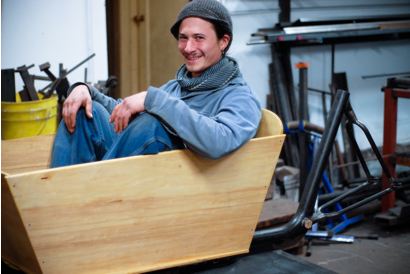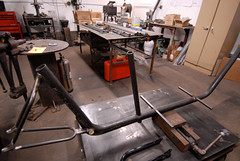
(Photo © J. Maus)
Since I first announced that a Portland-made bakfiets (Dutch for “box bike”) was in the works last May, the two men behind the project — 26 year-old Jamie Nichols and 38 year-old Phillip Ross — have made considerable progress.
The two partners will call their venture Metrofiets and they plan to soon offer a Portland-built, bakfiets-type cargo bike based on the proven design that has been in use in similar forms for nearly a century in Europe.
A few days ago I paid a visit to the shop in Northeast Portland where metal fabricator Jamie Nichols gave me an update and a sneak peek at the bike.
So far, Nichols and Ross have completed the design and fabrication of the main frame portion of the bike as well as the cargo box, which is also being built locally. At first glance, the Metrofiets looks like a carbon copy of the bakfiets design made popular by Dutch builder Maarten van Andel — and that’s no accident.
Nichols and Ross studied the existing bakfiets design extensively and used it as a jumping-off point for their creation.
“They’ve been doing this basic design for 100 years, so it’s pretty well figured out already,” says Nichols, “so we’ve taken that and added a bit of flair.”
Part of that flair, evident in the wishbone seat-stays, is inspired by Nichols’ love of vintage American bicycles like the Monark Silver King that were popular in cities like Chicago in the 1930s and ’40s.
According to Ross and Nichols, the other differences between their Metrofiets and the traditional bakfiets are that their bike will have a larger front wheel (24-inch instead of 20-inch) and a higher headset, which they say will “change the geometry so that it tracks differently.” Nichols also says the larger front wheel will help prevent speed-wobbles and will make the bike easier to control. Another difference is that the Metrofiets is made from 4130 chromoly, while the traditional bakfiets is made from a heavier grade of steel.
Ross, who works on the business end of the company, says they will also offer many customization options. “We’ll have a basic version available,” he says, “but we will also be able to tailor the size to the needs of any individual.” According to Ross, customers will be able to choose dropout types, component mix, and even frame angles depending on the kind of ride characteristics they prefer.
Both Ross and Nichols, who met 12 years ago in a Portland coffee house and have been friends ever since, say they want to keep their venture “hyper-local” and sustainable. They’re working with local craftsmen to build the cargo box (the current one was made out of a single piece of plywood and future models might be constructed from a ballistic nylon material instead of wood), and a local mobile bike mechanic will do all their builds and maintenance.
Current plans are to build two units a month for the first full year of production. Both Ross and Nichols shied away from a specific ETA for the bikes and they aren’t currently taking orders, but a final production model will almost certainly be ready to go by this September, when Nichols plans to ride a Metrofiets in Cycle Oregon.
View a few more photos of my visit to the Metrofiets shop in the photo gallery.



